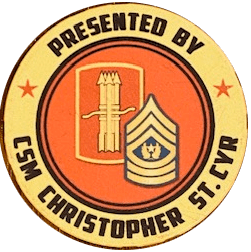
-Photo by Andrea Piacquadio on Pexels.com
Listening is a key leadership behavior that enables improved decision-making at lower levels, develops junior leaders, and opens the leader not only to influence others, but to be influenced. A Soldier I once led lead expressed this best during her promotion ceremony to Warrant Officer One. WO1 Connelly said, “I’m a firm believer that a good leader is equally shaped by their leaders and mentors, their peers, and their subordinates. To explain: While my leaders have mentored and coached me, my radar kids challenged me more as a leader than any mentor ever could, and my peers challenged me and shaped me within the organization because they knew me best.” Those influences helped her grow as a leader because she chose to listen to other’s feedback and input. While we expect to be influenced by our leaders, few ever consider how peers and subordinates also influence them. Those who fail to reflect on the influence of others miss opportunities to lead up and across their organizations.
Influence from, and influencing your leaders
Influence from our leaders is easy to recognize; every action and statement creates impressions required to accomplish tasks leading to mission accomplishment. Influencing leaders is an important aspect for followers; they know things the leaders do not. You create the ability to influence your leaders through your behaviors. Demonstrate that you are capable, value mission accomplishment, and treat clients, peers, and leaders respectfully. Likewise, listen to the valuable feedback from those you lead.
Influencing your peers
In every organization, there are overlaps of responsibility, authority, and resources. Leaders who influence peers are valued by their leaders. You develop influence with peers by treating them respectfully. Cast a vision demonstrating how both your teams win by working together. Give them credit when discussing successes with anyone. These behaviors will create trust and establish you as a safe working partner.
Being influenced by your followers
Learning to lead by allowing yourself to be influenced by those you lead is the peak skill for high performing leaders. Being influenceable means you listen to input, provide opportunities for others to make necessary decisions appropriate for their level and experience, and require junior leaders to do their own planning that properly supports your efforts. People respect leaders that provide them opportunities for growth. People will push the limits of their decision-making, authority, and policy restrictions. That’s okay because they know only confident leaders would give them space to engage in these behaviors. As the leader, you still have the ability to say no, enforce standards, and suggest alternatives, which means you are not a push over. These actions allow your people to grow and gain confidence.
Openness
When you start expecting leaders to act responsibly, most will gratefully accept the challenge. Be open about your reasons for loosening the reins. Set clear boundaries and expectations. Establish decision-making authority. You will be amazed at the growth you witness.

–Worcester Bus Depot yard site safety regulations by Jaggery is licensed under CC-BY-SA 2.0
For example, you may have a new front line leader running a team. Tell them as a leader you expect them to make appropriate decisions. You might allow them to plan schedules for their team, decide who can or should attend developmental or remedial training and similar activities. Likewise, clarify what decisions you expect to be briefed on, and which you retain for yourself or more senior leaders, such as approving payroll hours, or ordering durable equipment. Providing this clarity creates openness so people better understand what is wholly theirs, what is shared, and what is out of bounds.
Trust
This openness creates trust and a sense of safety critical to team building. You will need to make corrections along the way as people learn and grow. As their competence grows your trust grows in them allowing you to focus elsewhere. Everything rests on the trust cornerstone. Your people trust you more as you give them reasonable challenges, you trust them more as they successfully accomplish those challenges. Increased trust creates opportunities for you and your team to take on bigger challenges and achieve greater results.
Development
Creating a culture of influence increases the number of ideas available at any time to solve problems and identify improvements. As you counsel and coach those you lead, you develop better listening skills. You will hear things you did not hear from others before because of your new awareness, and because they will tell you more because they know you hear them. These experiences help them grow, becoming new leaders and better leaders. There is an old saying that the measure of a manager is dollars sold, widgets made, calls answered, or money saved; whereas there is only one measure of a leader, the number of leaders s/he develops.
When you open yourself up to be influenced by those you lead, you create a culture of openness that builds trust and develops future leaders. Just because you are currently in a leadership position doesn’t mean you are the smartest team member, know all the answers, or need to make all the decisions. Being open to the influence of others helps everyone learn and grow. There are few things in life more rewarding than hearing someone you used to lead talk about how they tried what you taught them, succeeded, and then passed that lesson on to another generation of leaders. Ms. Connelly is but one leader I helped on her path (I was not alone guiding her, only a small part of her learning). In a few years, she will be at a promotion ceremony and one of her former followers will have a little leadership lesson they share that will amaze her. You can be that leader too, but only after you are open to your followers’ influence.
References
- Connelly, N. (2025) Promotion ceremony speech. Concord, NH
- Covey, S (1989). The 7 habits of highly effective people. Fireside. New York, NY.
- Matton, J (2025). Here’s why successful leaders embrace bidirectional feedback. John Mattone Global. Retreived from: https://johnmattone.com/blog/heres-why-successful-leaders-embrace-bidirectional-feedback/ on 12/26/2025
- Willink, J. & Babbin, L. (2015). Extreme ownership. St. Martin’s Publishing Group. New York, NY.




























